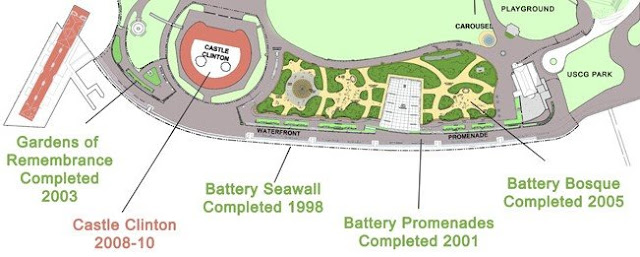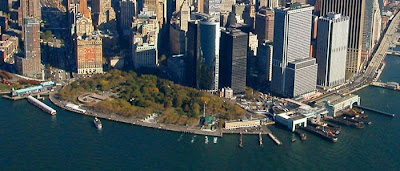
The Bosque garden at the Battery on the southern tip of Manhattan is a totally unexpected gift. Dirt paths flowing in a relaxed meander under the light cover of 140 London Plane trees define islands of perennial plantings. A grungy, neglected park has been remade through Piet Oudolf's design into a practical, durable, beautiful, and historically and culturally appropriate strolling garden that powerfully evokes the American prairies.
(Suspend for a moment the dissonance created by the idea of a prairie on New York Harbor.)
Relatively small, at only 60,000 square feet, the Bosque garden is easy to navigate. The paths offer plenty of opportunity for rambling, moving toward and away from the harbor, or to get a better view out - to the water, back to the towers of downtown Manhattan, a glimpse of the expensive apartment towers continuing to rise in Battery Park City.
The Challenge

This is the embarkation point for tour boats to the Statue of Liberty and Ellis Island, two of the most visited historic sites in the United States, if not the world. Any garden in this place must serve multiple purposes and balance many competing needs, offering an aesthetic and sensual experience for garden visitors, meaningful rationale for those familiar with the significant history of this site, and a pleasant environment for passersby, without creating a theme park-like atmosphere or unnecessarily intruding on the experience of those not interested in the garden. And it must be able to be maintained at reasonable cost and be made of durable materials, both hardscape and living.

Most visitors don't come to see the garden, so one might ask why make a garden here? Context provides the answer. New York City has embarked on a large-scale effort to recapture its waterfront. The Bosque garden is one spectacular link - indeed the southern starting point - of a linear park that will eventually extend up Manhattan's West Side from the Battery several miles to the north. It is a part of the re-greening of New York City that is evident to residents even in changing approaches to roadway design, proliferation of bicycle lanes, and numerous "traffic calming" measures throughout the City.
By any measure the Battery is a hostile place for a garden. The heavy pedestrian traffic and the exposed nature of the site - on the waterfront, with virtually no screening from wind, sun, and salt spray - wedged between heavily trafficked streets on the north and the harbor on the south, and with an extraordinary labyrinth of vehicular tunnels and infrastructure underground, would seem to militate against establishing a perennial garden here. What better designer than Piet Oudolf, who works in a vocabulary of plant materials characterized by sturdy geometric form, durable structure, and the ability to provide visual appeal even through winter weather? Because of the small size of the garden, the plants must do double and triple duty, maintaining their appeal for much longer than typical in most gardens. Though I did see some plants in less than pristine condition, such as Carex muskingumensis cut back to the ground, on the whole most plantings were thriving. Oudolf's perennial selections appear too be superbly adapted for this site.
The Meaning of the Place
Beyond the hostile environment, the multiple layers of historic and cultural associations present yet other challenges. The Battery sets off a kaleidoscopic burst of images and associations, making this a difficult place to design a garden appropriate to site, use and history.

Probably one of the most history-laden sites in North America, going back to the first settlement of New Amsterdam over 300 years ago - even before that, to the primeval forest that was home to the native Americans, the Lenni Lenape - the Battery brings to mind a wealth of historic associations. The original Dutch settlement, a private enterprise where commerce ruled the day, and where the first seeds of an open and free society were sown, was replaced early on by the English who imprinted their culture and language on the city. The superb harbor promoted development of a busy seafaring world that covered the waterfront all round this part of Manhattan. In the 18th century the Battery continued to be important in the defense of New York City and it played a significant role in the the American Revolution and later the War of 1812. George Washington was inaugurated as the nation's first President at Federal Hall just a few blocks to the north. Later cultural influences derived with the blossoming of Walt Whitman's prophetic and visionary voice in such emblematic poems as Crossing Brooklyn Ferry, and the epic construction of the Brooklyn Bridge, just to the north of the Battery on the East River. The Great Bridge is both a practical and an immensely symbolic structure apostrophised by the early modernist American poet Hart Crane as an arc of space and time that leaps from Europe and the urban east to the prairies at the center of the continent, imagined in cinematic terms as a metaphorical bridge carrying the millions of immigrants who passed through this harbor to new futures and distant geographies (“O Sleepless as the river under thee, vaulting the sea, the prairies' dreaming sod”), and finally the almost cliched icon of the Statue of Liberty.
Does it Work?
The Bosque garden must respond in a meaningful and satisfying way to all these challenges. This garden works, and it works on many different levels, from the most practical to the highly symbolic. (I was intrigued by the use of the name "Bosque". The word is used for small wooded areas that thrive in environmentally hostile areas along rivers in the southwestern U.S. and is derived from the Spanish, so it is an appropriate name in a metaphorical sense.)

The Bosque garden easily accommodates existing uses and features of the site. It works as a route of passage for the hundreds of thousands of tourists who pass it to reach the waterfront to view the Statue of Liberty or to reach the tour boats. Walkways direct the throngs from the heavily trafficked northern edge around Castle Clinton to the long queues for the boats, shown in the plan above from the Battery Conservancy web site. The garden edges this passageway, offering paths into the Bosque proper.
The garden also coexists comfortably with the large, rectangular East Coast Memorial, seen prominently in the plan above and the photo on the right, and a 40-foot-wide walkthrough fountain popular with children. By maintaining a low profile the garden easily plays the role of decorative background to the new fountain and the large, stiffly erect Memorial of stone monoliths with a giant stylized eagle.

By being so low key, the garden almost mocks the self-conscious aggrandizement of the Memorial.
Standards of maintenance in New York City parks are generally quite low. In this case, I'm sure the
Battery Conservancy is responsible for much more attentive maintenance than usual. The plantings too, as is typical with Oudolf designs, tend not to require a great deal of care, and are durable on their own. Over several years now, the Garden of Remembrance, which is really nothing more than the separately named waterside edge of the Bosque garden, and the Bosque itself have survived and even thrived in spite of apparently difficult environmental conditions, so the plantings can be said to work, and work well, on a practical level. I have only seen them in August, normally one of the hottest and most climatically stressful months in the City, and they were in amazingly good condition.
Anyone familiar with Oudolf's work will recognize many of the plants in the Bosque garden, but the design is not stale or formulaic. This is a risk of Oudolf's technique, based as it is on rather rigid planting principles with masses of astilbes, grasses, scutellaria, and other perennials in his pallet. We have seen many of the plant combinations before, but they are put to appropriate purpose here. Nearer the more crowded areas, the plantings are relatively low, maintaining an open view, and actually keeping the garden below the level of consciousness of most tourists, who after all are here to see the sights, not to visit a garden. For most of these visitors, the garden works on an almost unconscious level, serving only as a pleasant environment through which to walk.



For those visitors who want a garden, the plantings are low, like a low surf (many are groundcover), near the heavily trafficked end of Battery Park. As you stroll along the winding paths of sandy soil - surprisingly not stone or concrete, which you would expect - moving toward the east where the Staten Island Ferry Terminal blocks further passage - the plantings gradually build, like large waves of water, becoming looser, bulkier, taller, and taking on complex geometric shapes, very different in character from the rest of the garden.





A Conceptual Garden of Allusion
While it works as simply a beautiful, diverse, and intriguing planting, the Bosque garden is also a conceptual garden that works through allusion. How much of this is due to intellectual intent or simply to location and context I can't say. It may be that the garden, in its simplicity, takes on resonances of meaning just because it exists in this historic place.
Regardless, in the mind of this viewer it successfully negotiates the complex world of cultural symbols associated with the Battery and the concept of "America" epitomized in the Statue of Liberty and Ellis Island. The idea of "prairie" recalls a range of images, emotions, and stories emblematic of American history, from the "fruited plains" of the anthem "America" to the artistic vision of Willa Cather's
My Antonia set in the prairies of North Dakota, and could be seen to refer to innumerable other stories set in the American prairies. The symbolic journey begun at the Battery ends in a multitude of different places and times, but none more appropriate than the center of the North American continent, in words of William Cullen Bryant, in the place "for which the speech of England has no name". The prairie has become such a central concept in American culture and literature it is hard to visit this garden without finding one's thoughts turning to the many themes associated with the American prairie.
There is no doubt this is a highly artificial garden built in one of the most heavily used pedestrian areas in New York City, above rail and automobile tunnels, surrounded by the towers of downtown Manhattan. But it is a successful and beautiful garden that provides visual delight and respite. It meets the challenges of the site's use and exposure, and through the metaphor of the prairie, helps clarify the meaning of the historical and cultural clutter of the Battery's past.
The garden can be appreciated on the most basic level, as a collection of striking plantings and pleasant views. For those who bring an understanding of the history of New York City and the Battery, of the defining importance of the prairies (now mostly vanished) in American culture, and of the symbols that have become deeply embedded in American identity and the concept of Manifest Destiny, it offers a more meaningful, contemplative, and culturally self-critical experience.

(Photo of lower Manhattan and plan of the Battery are from The Battery Conservancy website. Other photos from August 11 post and Phillip Saperia.)






